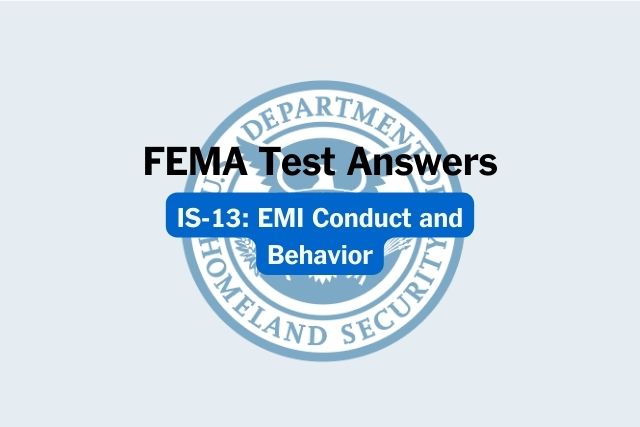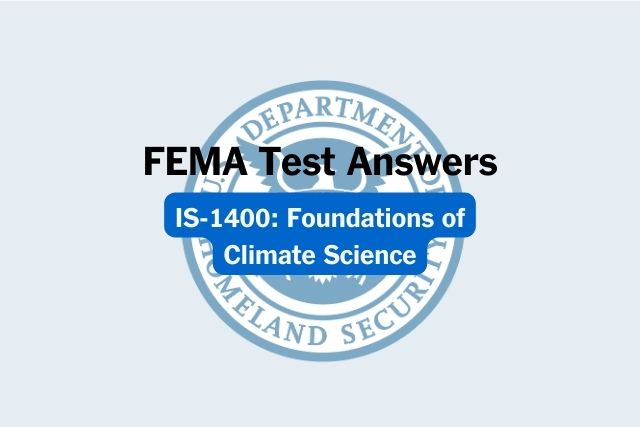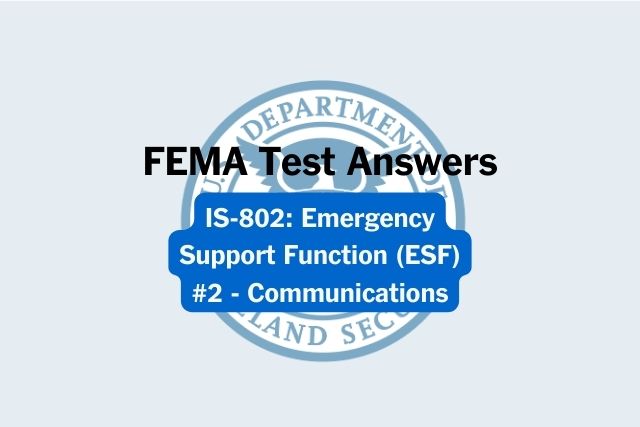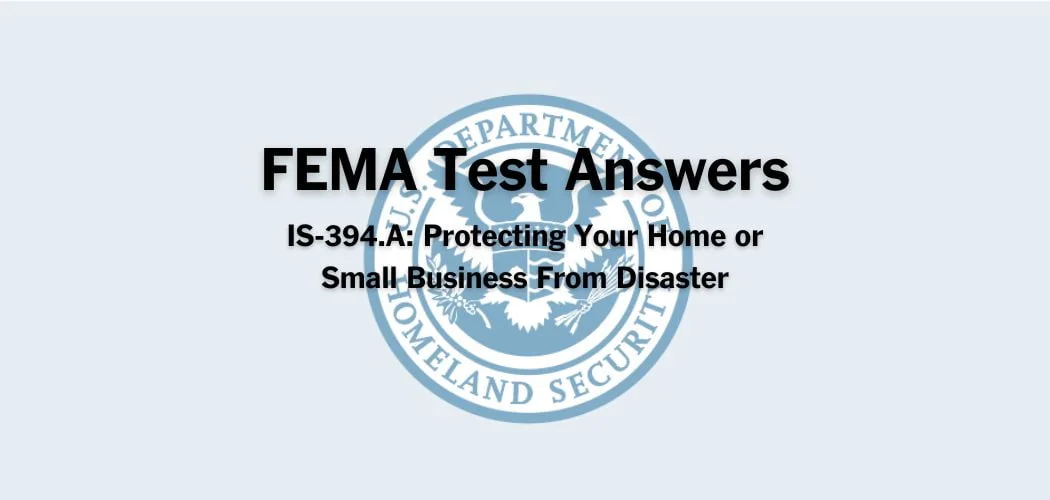Overview: The FEMA IS-280 course was published on 10/18/2013 to give an overview of the contents of the revised FEMA P-259, Engineering Principles, and Practices for Retrofitting Flood-Prone Residential Structures.
The objective of this course is to familiarize engineers, architects, floodplain managers, building code officials, hazard mitigation, planning, zoning, public works, and other building officials with the newly revised FEMA P-259 publication.
Primary audience: FEMA IS-280 is for engineers, architects, floodplain managers, building code officials, hazard mitigation, planning, zoning, public works, and other building officials with building science knowledge
FEMA IS-280 test answers
Each time this test is loaded, you will receive a unique set of questions and answers. The test questions are scrambled to protect the integrity of the exam.
Question 1. Slab-on-grade foundations are the most difficult foundation type to elevate.
A. TRUE✅
B. FALSE
Question 2. Which of the following items concerning community regulations and permitting must designers and contractors take into consideration?
A. Local codes
B. Potential system/utility upgrades
C. The impact on adjacent properties
D. All of the above✅
Question 3. According to the NFIP, in Zone A, the top of the lowest floor must be at or above the Base Flood Elevation, or BFE.
A. TRUE✅
B. FALSE
Question 4. For elevation, relocation, and dry/wet floodproofing measures, documentation of the condition of the existing structure and building systems is important.
A. TRUE✅
B. FALSE
Question 5. Which of the following types of flood-related hazards apply to all sites?
A. Flood forces and loads
B. Flood elevations
C. Site drainage
D. All of the above✅
Question 6. Interior drainage is a consideration when constructing a levee or floodwall.
A. TRUE✅
B. FALSE
Question 7. A structure’s ability to withstand additional loads created as a result of retrofitting is an important design consideration.
A. TRUE✅
B. FALSE
Question 8. If the retrofit measure requires that the building be brought to current code, new systems/utilities may be required.
A. TRUE✅
B. FALSE
Question 9. Which of the following is not a common reason for making the decision to retrofit?
A. Witnessing or experiencing a flooding event
B. Substantial damages from a flood or other event
C. Aesthetic concerns✅
D. Implementation of a substantial improvement
Question 10. Which of the following is a retrofitting measure for flood hazards?
A. Wet Floodproofing
B. Floodwalls
C. Relocation
D. All of the Above✅
Question 11. Buildings must have sufficient strength to resist applied loads from both positive and negative pressures if they will be subject to wind forces.
A. TRUE✅
B. FALSE
Question 12. The NFIP was created to:
A. Guide future development away from flood hazard areas
B. Ensure that new and substantially improved construction is resistant to flood damage
C. Transfer costs of flood losses from taxpayers to owners of flood-prone property
D. All of the above✅
Question 13. Which of the following is not part of the process for analyzing an existing structure for retrofitting, according to the steps outlined in this presentation?
A. Structural reconnaissance
B. Determining the costs of proposed retrofitting measures✅
C. Calculating the capacity of the existing structure to resist the additional loads
D. Determining the capacity of the existing footing and foundation system to withstand the loads that would be imposed by the retrofitting measure
Question 14. Land subsidence occurs over more than _____ square miles in ___ States each year.
A. 10,000, 13
B. 15,000, 20
C. 17,000, 45✅
D. 20,000, 25
Question 15. Preventive flooding measures to historic sites can be carried out without harming the historic character if a general construction contractor supervises the work.
A. TRUE
B. FALSE✅
Question 16. For the most part, ______ and _____ governments are responsible for regulating building and development within floodplains.
A. State, localv
B. Federal, State
C. Federal, local
D. None of the above
Question 17. Determining the hazards that could affect a property is one of the steps in the retrofitting process.
A. TRUE✅
B. FALSE
Question 18. When retrofitting a historic site, some flood retrofit measures could negatively impact the historic character of the building. Which of the following should designers consider in choosing the most appropriate retrofitting strategy?
A. The risk of doing nothing
B. The value of the historic structure
C. Whether there is a design treatment that could be applied to the preventive measure to lessen the detraction of the site’s historic character
D. Both A and B
E. Both A and C✅
Question 19. Debris impact is not a parameter that designers and contractors should consider when retrofitting a building.
A. TRUE
B. FALSE✅
Question 20. The NFIP provides federally-backed flood insurance to property owners and renters regardless of their location.
A. TRUE
B. FALSE✅
Question 21. Flood frequency is the characteristic that describes the probability that a flood of a specific magnitude will be equaled or exceeded in any given year.
A. TRUE✅
B. FALSE
Question 22. Which of the following are standards that communities may adopt that are higher than those required by the NFIP?
A. Adding freeboard to elevation requirements
B. Requirements regarding the use and type of fill
C. Requirements for building materials and practices
D. All of the above✅
Question 23. Contractors and designers should consider the following when consulting with homeowners:
A. Reasons for retrofitting
B. Expected benefits of the project
C. Financial considerations
D. All of the above✅
Question 24. Building performance requirements for the NFIP are found in Title 45 of the Code of Federal Regulations (CFR).
A. TRUE✅
B. FALSE
Question 25. The 2012, 2009, 2006, and 2003 versions of the I-Codes are consistent with the NFIP.
A. TRUE✅
B. FALSE
Question 26. During the design process, it is important to conduct both surface and subsurface investigations.
A. TRUE✅
B. FALSE
Question 27. The flood elevations at the site of a retrofit project must be considered only in coastal flood hazard areas.
A. TRUE
B. FALSE✅
Question 28. Which of the following is an advantage to elevation?
A. Does not alter access to the structure
B. Completely eliminates the flood risk to the structure
C. Often reduces flood insurance premiums✅
D. Eliminates the need to evacuate during floods
Question 29. One component of the retrofitting process is conducting a benefit-cost analysis.
A. TRUE✅
B. FALSE
Question 30. Wet floodproofing allows floodwater to enter in such a way that damage to the structure and its contents is minimized.
A. TRUE✅
B. FALSE
Question 31. As of January 2012, ___ of flood-prone communities have adopted codes that meet or exceed the NFIP.
A. 25 percent
B. 47 percent✅
C. 62 percent
D. 85 percent
Question 32. Three types of site-specific flood-related hazards that should be considered include closed basin lakes, alluvial fan areas, and movable bed streams.
A. TRUE✅
B. FALSE
Question 33. The Preliminary Floodproofing/Retrofitting Preference Matrix helps designers and contractors ensure the homeowner signs off on all elements of the project.
A. TRUE✅
B. FALSE
Question 34. Which of the following is not a consideration when retrofitting for flood events?
A. Codes, ordinances, and regulations
B. Consultation with professionals for design and construction✅
C. Occupation of retrofitted structures during a flood event
D. Maintenance of retrofitting measures should be included in plans
Question 35. Which of the following is not a geotechnical consideration to review during site inspections?
A. Potential for scouring
B. Saturated soil forces
C. High watermarks✅
D. Permeability
Question 36. When evaluating sites for possible relocation, which of the following are considerations for a new site?
A. Utility extension feasibility
B. Permitting feasibility for the house on the new lot
C. Accessibility for the homeowners as well as relocation/construction crews
D. All of the above✅
Question 37. What are the three types of site surveys generally included in a field investigation?
A. Topographic, hazard, site utilities
B. Homeowner, structure, topographic
C. Structure, topographic, site utilities✅
D. Homeowner, hazard, structure
Question 38. Once flood retrofitting is complete, flood insurance is no longer needed.
A. TRUE
B. FALSE✅
Question 39. A movable bed stream is defined as a stream for which erosion, sedimentation, or channel migration cause changes in the stream sufficient to change the flood elevation of the floodplain.
A. TRUE
B. FALSE✅



